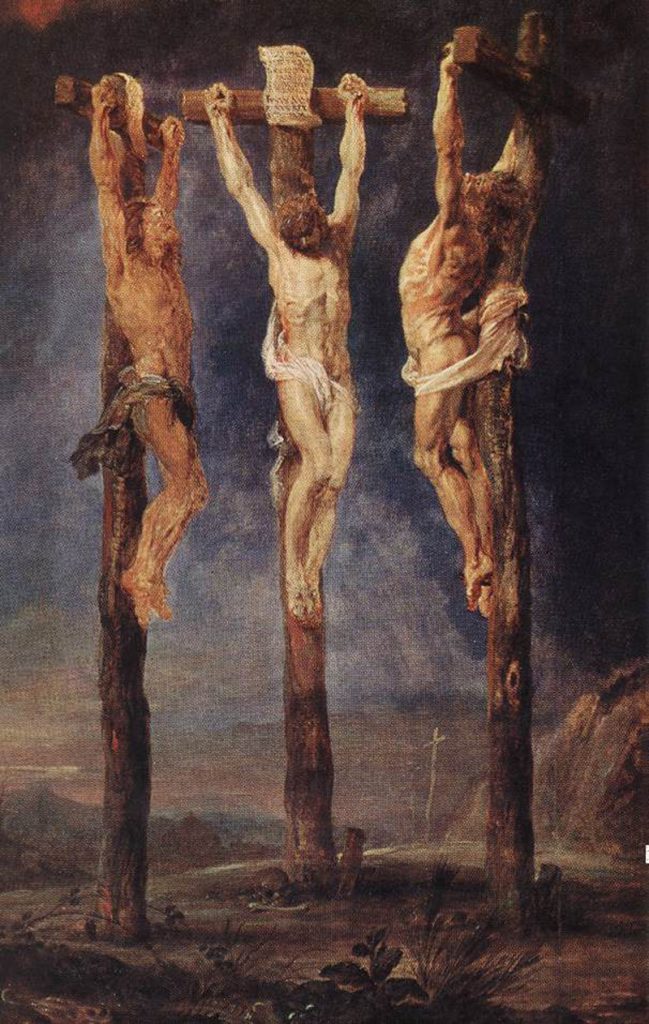I was reading the lessons appointed for Friday, Proper 17 and found a bit of a surprise in Mark 15:27: “And with him they crucified two bandits, one on his right and one on his left.”
This was different than what I remembered of the story. I remembered them as thieves, and that word has a different connotation to me than ‘bandits’.
I didn’t know where I got the idea they were robbers or thieves from, but it was so entrenched in my mind, that when I went to search the other crucifixion narratives for where I might have gotten the idea I used tried using the search terms “thief” and “robber” and came up empty.
However, then it occurred to me that the very first bible I ever read was the King James Version (yes, I was a strange child). In that version the verse reads: “And with him they crucify two thieves; the one on his right hand, and the other on his left.”
I also remembered the two men having a conversation with Jesus that was missing in the Mark version. I found it in the Luke narrative, but it was shorter than I remembered.
I suspect that additional details of the crucifixion narrative have slowly accumulated and become attached to my version of the story. Everything from the musical “Jesus Christ Superstar,” to Easter Services, to different translations of the bible, to Sunday School teachings, to historical accounts of the time of rattle around in my brain.
Since humans are natural storytellers, it is second nature for my mind to take all of the bits and pieces from different sources and try to weld them into a whole and consistent narrative. I have an impulse to make stories work and to fix them if they don’t make sense.
So when I read the passage from Mark and really looked at the words. I was surprised to see that my memory and personal story didn’t match the text.
Given this experience, I think it is very valuable to go back and re-read the actual text from time-to-time and not just rely on my memories of the stories of the Bible, especially since I’ve seen how my own inner-storyteller is willing to edit, adapt, and transform the narratives without my even realizing it.
I’m not saying that any one translation of the biblical text is the One True way. I still think that, as a living follower of Jesus, my understanding and faith are shaped both by scripture and by my actual lived experience and which will be very different than that of people who lived 100, 500, or 1000 years ago.
However, there is a difference between passively accepting the narrative I have constructed out of bits of the various gospels, cultural depictions of a biblical story, and other random trivia I’ve picked up here and there; and consciously re-reading the stories in the New Testament, exploring different translations, learning about the historical context in which they were formed, and meditating on how those stories play out in my own life today.
There is value in reviewing what I think I know. Re-reading the stories of my faith and re-examining the stories I tell myself, grounds me and helps me focus on the essentials: the love Jesus has for us and the love he expected us to share.
As it says in the collect for this week: Lord of all power and might, the author and giver of all good things: Graft in our hearts the love of your Name; increase in us true religion; nourish us with all goodness; and bring forth in us the fruit of good works; through Jesus Christ our Lord, who lives and reigns with you and the Holy Spirit, one God for ever and ever. Amen.
————–
Quotations are from the New Revised Standard Edition and King James versions of the bible found at Bible Gateway and from the Book of Common Prayer.
Kristin Fontaine is an itinerant Episcopalian, crafter, hobbyist, and unstoppable organizer of everything. Advent is her favorite season, but she thinks about the meaning of life and her relationship to God year-round. It all spills out in the essays she writes. She and her husband own Dailey Data Group, a statistical consulting company.
© 2019 Kristin Fontaine

